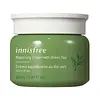What's inside
What's inside
 Key Ingredients
Key Ingredients

 Benefits
Benefits

 Concerns
Concerns

 Ingredients Side-by-side
Ingredients Side-by-side

Water
Skin ConditioningPropanediol
SolventCetyl Ethylhexanoate
EmollientButylene Glycol
HumectantMethyl Trimethicone
Skin ConditioningGlycerin
HumectantHydrogenated Poly(C6-14 Olefin)
EmollientC14-22 Alcohols
Emulsion Stabilising1,2-Hexanediol
Skin ConditioningSqualane
EmollientNiacinamide
SmoothingStearic Acid
CleansingGlyceryl Stearate
EmollientBetaine
HumectantPalmitic Acid
EmollientArachidyl Alcohol
EmollientC12-20 Alkyl Glucoside
EmulsifyingHydroxyethyl Acrylate/Sodium Acryloyldimethyl Taurate Copolymer
Emulsion StabilisingSilica
AbrasiveAcrylates/C10-30 Alkyl Acrylate Crosspolymer
Emulsion StabilisingBehenyl Alcohol
EmollientGlyceryl Caprylate
EmollientArachidyl Glucoside
EmulsifyingTromethamine
BufferingDisodium EDTA
Ethylhexylglycerin
Skin ConditioningCamellia Sinensis Leaf Extract
AntimicrobialSorbitan Isostearate
EmulsifyingArginine
MaskingAspartic Acid
MaskingGlutamic Acid
HumectantHyaluronic Acid
HumectantZinc PCA
HumectantGluconolactone
Skin ConditioningGlucose
HumectantTocopherol
AntioxidantWater, Propanediol, Cetyl Ethylhexanoate, Butylene Glycol, Methyl Trimethicone, Glycerin, Hydrogenated Poly(C6-14 Olefin), C14-22 Alcohols, 1,2-Hexanediol, Squalane, Niacinamide, Stearic Acid, Glyceryl Stearate, Betaine, Palmitic Acid, Arachidyl Alcohol, C12-20 Alkyl Glucoside, Hydroxyethyl Acrylate/Sodium Acryloyldimethyl Taurate Copolymer, Silica, Acrylates/C10-30 Alkyl Acrylate Crosspolymer, Behenyl Alcohol, Glyceryl Caprylate, Arachidyl Glucoside, Tromethamine, Disodium EDTA, Ethylhexylglycerin, Camellia Sinensis Leaf Extract, Sorbitan Isostearate, Arginine, Aspartic Acid, Glutamic Acid, Hyaluronic Acid, Zinc PCA, Gluconolactone, Glucose, Tocopherol
Water
Skin ConditioningPropanediol
SolventPentaerythrityl Tetraethylhexanoate
Emollient1,2-Hexanediol
Skin ConditioningHydrogenated Poly(C6-14 Olefin)
EmollientC14-22 Alcohols
Emulsion StabilisingCarbomer
Emulsion StabilisingTromethamine
BufferingC12-20 Alkyl Glucoside
EmulsifyingParfum
MaskingEthylhexylglycerin
Skin ConditioningDisodium EDTA
Camellia Sinensis Leaf Extract
AntimicrobialGlycine Soja Oil
EmollientGlucose
HumectantAlthaea Officinalis Root Extract
Skin ConditioningWater, Propanediol, Pentaerythrityl Tetraethylhexanoate, 1,2-Hexanediol, Hydrogenated Poly(C6-14 Olefin), C14-22 Alcohols, Carbomer, Tromethamine, C12-20 Alkyl Glucoside, Parfum, Ethylhexylglycerin, Disodium EDTA, Camellia Sinensis Leaf Extract, Glycine Soja Oil, Glucose, Althaea Officinalis Root Extract
 Reviews
Reviews

Ingredients Explained
These ingredients are found in both products.
Ingredients higher up in an ingredient list are typically present in a larger amount.
1,2-Hexanediol is a synthetic liquid and another multi-functional powerhouse.
It is a:
- Humectant, drawing moisture into the skin
- Emollient, helping to soften skin
- Solvent, dispersing and stabilizing formulas
- Preservative booster, enhancing the antimicrobial activity of other preservatives
We don't have a description for C12-20 Alkyl Glucoside yet.
C14-22 Alcohols is made up of synthetic fatty alcohols. More specifically, these fatty alcohols contain 14 to 22 carbons in the alkyl chain.
Its main purpose is to stabilize products. As an emulsifier, it helps prevent waters and oils from separating.
Camellia Sinensis Leaf Extract is derived from the leaves of the tea plant. Black tea, green tea, and oolong tea are all harvested from this plant.
This ingredient has many skin benefits:
This ingredient contains polyphenols, a strong antioxidant. Antioxidants help fight off molecules that damage skin cells.
On top of that, the antioxidants in green tea neutralize free-radicals from the sun. This gives the skin some extra UV protection, but should not replace sunscreen.
Many components of tea have anti-inflammatory properties.
Polyphenols and L-theanine help soothe the skin and reduce irritation. The caffeine in Camellia Sinensis Leaf Extract helps calm inflamed blood vessels.
Other compounds found in tea include: Vitamin Bs, linoleic acid, magnesium, calcium, iron, and zinc.
Research has shown both drinking Camellia Sinensis Leaf Tea and applying it to the skin can help boost skin elasticity and hydration. Studies also show using tea extract may reduce sebum, or oil, production.
Learn more about Camellia Sinensis Leaf ExtractDisodium EDTA plays a role in making products more stable by aiding other preservatives.
It is a chelating agent, meaning it neutralizes metal ions that may be found in a product.
Disodium EDTA is a salt of edetic acid and is found to be safe in cosmetic ingredients.
Learn more about Disodium EDTAEthylhexylglycerin (we can't pronounce this either) is commonly used as a preservative and skin softener. It is derived from glyceryl.
You might see Ethylhexylglycerin often paired with other preservatives such as phenoxyethanol. Ethylhexylglycerin has been found to increase the effectiveness of these other preservatives.
Glucose is a simple sugar and is the most important source of energy in all organisms.
In skincare, glucose is used to hydrate the skin. It also acts as a prebiotic for our natural biome.
Glucose is hydrating due to its humectant property. As a humectant, glucose draws moisture from the air and from deeper levels in the skin.
Our skin contains many sugars that act as prebiotics and help strengthen our natural microbiome. Having a healthy microbiome helps protect our skin from harmful bacteria and other contaminants.
Studies show glucose may help with fading discoloration and pigmentation. This is because our skin metabolizes glucose into lactic acid. Lactic acid is an AHA that helps exfoliate the top layer of skin.
Learn more about GlucoseWe don't have a description for Hydrogenated Poly(C6-14 Olefin) yet.
Propanediol is an all-star ingredient. It softens, hydrates, and smooths the skin.
It’s often used to:
Propanediol is not likely to cause sensitivity and considered safe to use. It is derived from corn or petroleum with a clear color and no scent.
Learn more about PropanediolTromethamine helps balance the pH and improve the texture of a product. It is synthetically created.
As an emulsifier, Tromethamine prevents oil and water ingredients from separating. This helps stabilize the product and elongate a product's shelf life. Tromethamine also makes a product thicker.
Tromethamine helps balance the pH level of a product. Normal pH level of skin is slightly acidic (~4.75-5.5). The acidity of our skin is maintained by our glands and skin biome. Being slightly acidic allows our skin to create an "acid mantle". This acid mantle is a thin barrier that protects our skin from bacteria and contaminants.
Oral Tromethanmine is an anti-inflammatory drug but plays the role of masking, adding fragrance, and/or balancing pH in skincare.
1,3-Propanediol, 2-amino-2-(hydroxymethyl)-
Learn more about TromethamineWater. It's the most common cosmetic ingredient of all. You'll usually see it at the top of ingredient lists, meaning that it makes up the largest part of the product.
So why is it so popular? Water most often acts as a solvent - this means that it helps dissolve other ingredients into the formulation.
You'll also recognize water as that liquid we all need to stay alive. If you see this, drink a glass of water. Stay hydrated!
Learn more about Water